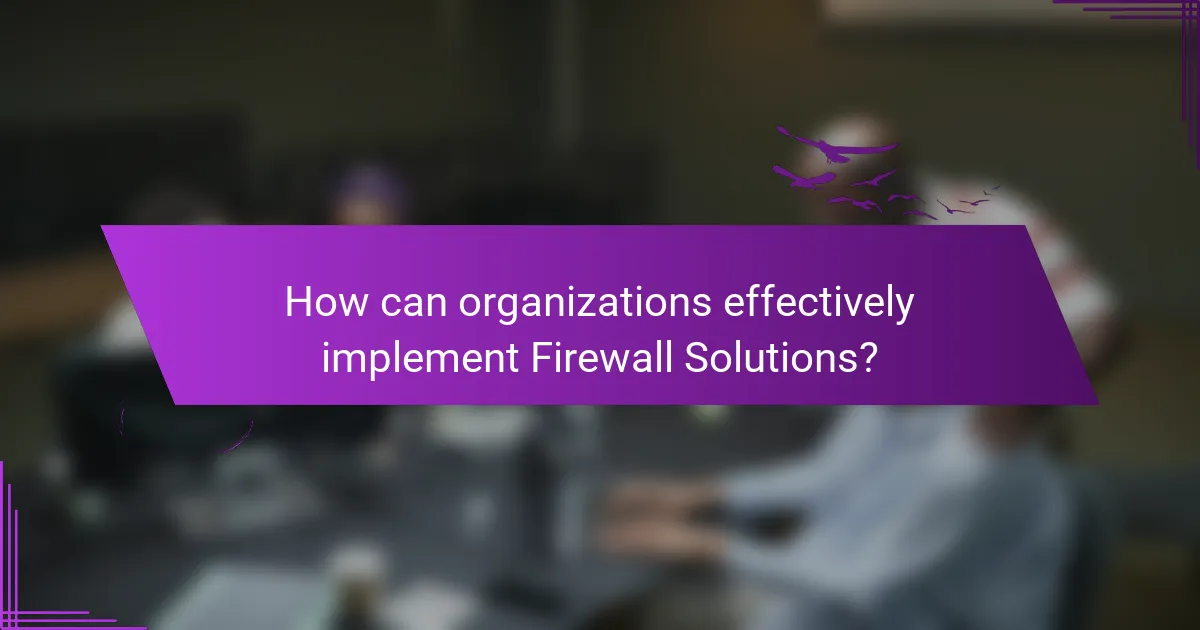
What are Firewall Solutions?
Firewall solutions are security systems that monitor and control incoming and outgoing network traffic. They establish a barrier between trusted internal networks and untrusted external networks. Firewalls can be hardware-based, software-based, or a combination of both. Their primary function is to block unauthorized access while permitting outward communication. According to the Cybersecurity & Infrastructure Security Agency, firewalls are essential for protecting sensitive data. They can also provide logging and reporting capabilities to track network activity. Firewall solutions are crucial in preventing cyber attacks and maintaining network integrity.
How do Firewall Solutions function to protect networks?
Firewall solutions function by monitoring and controlling incoming and outgoing network traffic. They establish a barrier between trusted internal networks and untrusted external networks. Firewalls use predetermined security rules to allow or block data packets. They can operate at various levels, including network, transport, and application layers.
By examining the header information of data packets, firewalls can identify potential threats. They also track active connections and can terminate suspicious activities. Some firewalls include features like intrusion detection and prevention systems. According to a report by Cybersecurity Ventures, global spending on firewall solutions is projected to exceed $8 billion by 2025, highlighting their importance in network security.
What are the key components of Firewall Solutions?
The key components of firewall solutions include packet filtering, stateful inspection, proxy services, and application-layer filtering. Packet filtering examines data packets and allows or blocks them based on predefined rules. Stateful inspection monitors active connections and makes decisions based on the state of the traffic. Proxy services act as intermediaries between users and the internet, providing an additional layer of security. Application-layer filtering inspects the content of the traffic to enforce security policies. These components work together to provide comprehensive network security against unauthorized access and threats.
How do different components interact within Firewall Solutions?
Firewall solutions consist of multiple components that interact to provide security. The main components include the firewall engine, policy management, logging, and monitoring systems. The firewall engine processes incoming and outgoing traffic based on predefined rules. Policy management defines these rules and determines what traffic is allowed or blocked. Logging records events for analysis and troubleshooting. Monitoring systems provide real-time insights into traffic patterns and potential threats. These components work together to create a cohesive security framework. For example, when a threat is detected, the monitoring system alerts the firewall engine to take action based on the established policies. This interaction ensures that the network remains secure and responsive to threats.
What types of Firewall Solutions are available?
There are several types of firewall solutions available. These include packet-filtering firewalls, which inspect packets and allow or block them based on predefined rules. Stateful inspection firewalls track active connections and make decisions based on the state of the connection. Proxy firewalls act as intermediaries between users and services, filtering requests and responses. Next-generation firewalls combine traditional features with advanced capabilities like intrusion prevention and application awareness. Cloud firewalls are deployed in cloud environments and provide scalable protection. Finally, software firewalls run on individual devices, offering personalized protection. Each type serves specific security needs and is essential for comprehensive network protection.
What distinguishes hardware firewalls from software firewalls?
Hardware firewalls are physical devices dedicated to network security, while software firewalls are applications installed on devices. Hardware firewalls typically provide a higher level of security because they operate independently of the devices they protect. They are placed between the network and the internet, filtering traffic before it reaches internal systems. Software firewalls, on the other hand, run on individual devices and protect them from threats originating from the internet.
Hardware firewalls often support multiple users and devices simultaneously, making them suitable for larger networks. They can handle more extensive traffic and provide faster response times. Software firewalls are generally easier to configure and maintain for individual users. They can be updated frequently to address new threats.
In summary, the main distinction lies in their deployment: hardware firewalls are standalone devices for network protection, while software firewalls are installed on individual computers for personal security.
How do next-generation firewalls differ from traditional firewalls?
Next-generation firewalls (NGFWs) differ from traditional firewalls by incorporating advanced features beyond basic packet filtering. NGFWs provide deep packet inspection, which allows them to analyze the data within packets, not just their headers. They also include application awareness, enabling them to identify and control applications regardless of port or protocol. Additionally, NGFWs integrate intrusion prevention systems (IPS) to detect and block threats in real-time. Traditional firewalls primarily focus on perimeter security and do not offer these advanced capabilities. According to a report by Gartner, NGFWs are essential for modern security strategies due to the increasing sophistication of cyber threats.
What advantages do Firewall Solutions provide?
Firewall solutions provide enhanced security for networks. They act as a barrier between trusted internal networks and untrusted external networks. Firewalls monitor and control incoming and outgoing network traffic based on predetermined security rules. This helps in preventing unauthorized access to sensitive data.
Additionally, firewalls can detect and block malicious traffic, protecting against cyber threats. They can also log traffic data for analysis and compliance purposes. According to a study by Cybersecurity Ventures, global cybercrime damages are expected to reach $10.5 trillion annually by 2025. Implementing firewall solutions can significantly reduce the risk of such financial losses.
How do Firewall Solutions enhance network security?
Firewall solutions enhance network security by monitoring and controlling incoming and outgoing network traffic. They act as a barrier between trusted internal networks and untrusted external networks. Firewalls use predefined security rules to permit or block data packets. This helps prevent unauthorized access to sensitive data and systems.
Additionally, firewalls can detect and mitigate threats such as malware and intrusion attempts. They often include features like VPN support and content filtering. According to the Cybersecurity & Infrastructure Security Agency (CISA), effective firewall deployment is essential for protecting networks from cyber threats. These measures significantly reduce the risk of data breaches and enhance overall network integrity.
What cost benefits can organizations gain from implementing Firewall Solutions?
Organizations can gain significant cost benefits from implementing Firewall Solutions. They reduce the risk of data breaches, which can save organizations millions in potential fines and remediation costs. According to IBM’s 2021 Cost of a Data Breach Report, the average total cost of a data breach is $4.24 million. Firewalls help prevent unauthorized access, thereby minimizing the likelihood of such incidents.
Additionally, firewall solutions can lower IT operational costs. By streamlining network security management, organizations can reduce the need for extensive IT staff dedicated to monitoring threats. This efficiency can lead to savings on labor costs and resource allocation.
Furthermore, firewalls can decrease the costs associated with downtime. Cyberattacks can lead to significant operational disruptions. A study by the Ponemon Institute found that the average cost of downtime is approximately $5,600 per minute. By preventing attacks, firewalls can help maintain business continuity and protect revenue.
In summary, implementing Firewall Solutions can lead to substantial cost savings through reduced breach risks, lower operational expenses, and minimized downtime costs.

How can organizations effectively implement Firewall Solutions?
Organizations can effectively implement firewall solutions by following a structured approach. First, they should assess their network requirements and security needs. This includes identifying sensitive data and potential threats. Next, selecting the appropriate type of firewall is crucial. Options include hardware, software, and cloud-based firewalls.
After selection, organizations must configure the firewall according to best practices. This includes setting rules for inbound and outbound traffic. Regular updates and patches should be applied to maintain security. Monitoring and logging traffic is essential for detecting anomalies.
Finally, conducting regular audits and assessments ensures the firewall remains effective. According to a report by Cybersecurity Ventures, organizations that implement robust firewall solutions can reduce security breaches by up to 50%.
What best practices should be followed when deploying Firewall Solutions?
Implementing firewall solutions requires adherence to several best practices. First, conduct a thorough risk assessment to identify vulnerabilities. This assessment informs the firewall configuration and rules. Second, ensure that the firewall is configured according to the principle of least privilege. Only necessary traffic should be allowed, minimizing exposure to threats. Third, regularly update firewall firmware and software to protect against known vulnerabilities. Keeping the system updated is crucial for maintaining security. Fourth, implement logging and monitoring to track traffic patterns and detect anomalies. This enables quick responses to potential threats. Lastly, conduct regular audits and reviews of firewall rules and configurations. This practice ensures that the firewall remains effective against evolving threats.
How can organizations assess their specific firewall needs?
Organizations can assess their specific firewall needs by evaluating their network architecture and security requirements. They should identify the types of data they handle and the potential threats they face. Conducting a risk assessment helps determine vulnerabilities in the network. Organizations must also consider the size and complexity of their network infrastructure. Analyzing traffic patterns can provide insights into performance requirements. Consulting with cybersecurity experts can further clarify specific needs. Lastly, reviewing compliance regulations relevant to their industry is essential for proper firewall configuration.
What role does regular maintenance play in Firewall Solutions effectiveness?
Regular maintenance is crucial for the effectiveness of firewall solutions. It ensures that the firewall is updated with the latest security patches. This helps to protect against newly discovered vulnerabilities. Regular maintenance also involves monitoring traffic patterns and adjusting rules accordingly. This proactive approach can prevent unauthorized access and data breaches. Additionally, routine checks can identify and resolve configuration issues. According to cybersecurity experts, 90% of successful attacks exploit known vulnerabilities. Therefore, consistent maintenance is essential for optimal firewall performance and security.
What common challenges do organizations face with Firewall Solutions?
Organizations face several common challenges with firewall solutions. One major challenge is configuration complexity. Firewalls require precise settings to function effectively. Misconfigurations can lead to security vulnerabilities. Another challenge is performance impact. Firewalls can slow down network traffic if not optimized. This can affect user experience and productivity. Additionally, organizations struggle with keeping firewall rules updated. Cyber threats evolve, necessitating regular updates to firewall policies. Lastly, there is often a lack of visibility. Many firewalls do not provide comprehensive monitoring capabilities. This can hinder incident response and threat detection.
How can organizations troubleshoot common issues with Firewall Solutions?
Organizations can troubleshoot common issues with firewall solutions by systematically identifying and addressing potential problems. First, they should verify the firewall’s configuration settings. Misconfigurations often lead to connectivity issues. Next, organizations must check the firewall logs for any error messages or alerts. These logs provide insights into blocked traffic and potential threats. Additionally, conducting regular updates and patches is crucial. Outdated firmware can result in vulnerabilities and performance issues.
Testing the network connection is also essential. A simple ping test can help determine if the firewall is operational. If issues persist, organizations should consider restarting the firewall. This action can resolve temporary glitches. Lastly, consulting vendor documentation can provide specific troubleshooting steps tailored to the firewall model. Following these methods can effectively address common firewall issues.
What are the risks of misconfiguring Firewall Solutions?
Misconfiguring firewall solutions poses significant security risks. It can lead to unauthorized access to sensitive data and systems. This is often due to improperly set rules or policies that fail to block malicious traffic. Additionally, misconfigurations can create vulnerabilities that attackers can exploit. For example, a firewall might allow incoming traffic from untrusted sources. This can result in data breaches or malware infections. According to a study by the Ponemon Institute, 60% of organizations experienced a data breach due to misconfigured security settings. Therefore, proper configuration is essential to maintain network security and integrity.

What emerging trends are influencing Firewall Solutions?
Emerging trends influencing firewall solutions include the integration of artificial intelligence (AI) and machine learning (ML). These technologies enhance threat detection and response capabilities. AI and ML can analyze vast amounts of data for identifying patterns indicative of cyber threats. Another trend is the shift towards cloud-based firewall solutions. This allows for scalability and flexibility in managing network security. Additionally, the rise of remote work has increased the demand for secure access solutions. Zero Trust security models are gaining traction, emphasizing verification for every user and device. Finally, regulatory compliance requirements are shaping firewall features to ensure data protection. These trends reflect the evolving landscape of cybersecurity.
How is cloud technology impacting Firewall Solutions?
Cloud technology is significantly impacting firewall solutions by enabling scalable and flexible security measures. Traditional firewalls often struggle with the dynamic nature of cloud environments. Cloud-based firewalls offer centralized management, allowing for easier updates and policy enforcement across multiple locations. This approach enhances security visibility and reduces response times to threats. Additionally, cloud firewalls can automatically scale resources based on traffic demands, ensuring consistent performance. According to a report by Gartner, cloud security services are expected to grow significantly, reflecting the increasing reliance on cloud infrastructure. This shift indicates a trend towards integrating firewall solutions with cloud technology for better protection.
What are the implications of integrating AI with Firewall Solutions?
Integrating AI with firewall solutions enhances threat detection and response capabilities. AI algorithms analyze network traffic patterns in real-time. This allows for quicker identification of anomalies and potential threats. Traditional firewalls often rely on predefined rules, which can be bypassed by sophisticated attacks. AI-driven firewalls adapt to new threats by learning from data. They can predict and mitigate risks based on historical behavior. According to a report by Gartner, AI can reduce incident response times by up to 90%. This integration also leads to improved automation of security processes. Overall, AI significantly strengthens the effectiveness of firewall solutions.
What practical tips can enhance the effectiveness of Firewall Solutions?
To enhance the effectiveness of Firewall Solutions, regularly update the firewall software. Updating ensures protection against the latest threats. Implementing a layered security approach can also improve effectiveness. This includes using additional security measures alongside firewalls. Configuring rules and policies properly is crucial. Misconfigured settings can leave vulnerabilities. Regularly reviewing logs helps identify suspicious activities. Monitoring network traffic provides insights into potential threats. Conducting periodic security audits strengthens firewall performance. Engaging in user training raises awareness about security practices. These tips collectively enhance the overall security posture provided by firewall solutions.
How can organizations regularly update their Firewall Solutions to stay protected?
Organizations can regularly update their Firewall Solutions by implementing a structured update schedule. This schedule should include routine checks for software and firmware updates. Regularly reviewing security policies and configurations is essential. Conducting vulnerability assessments can identify areas needing improvement. Utilizing automated tools for updates can enhance efficiency. Training staff on the latest security threats is also crucial. Monitoring firewall logs helps detect potential issues early. According to a report by Cybersecurity & Infrastructure Security Agency, frequent updates significantly reduce vulnerability to attacks.
What training should staff receive to manage Firewall Solutions effectively?
Staff should receive training in network security principles to manage Firewall Solutions effectively. This training should cover the fundamentals of firewalls, including types, configurations, and deployment strategies. Employees must understand how to monitor firewall logs for suspicious activity. They should also learn about threat detection and mitigation techniques. Knowledge of compliance requirements and best practices is essential. Training should include hands-on experience with firewall management tools. Additionally, staff should stay updated on emerging threats and firewall technologies. Regular training sessions can enhance their skills and knowledge over time.
Firewall solutions are essential security systems that monitor and control network traffic, establishing a barrier between trusted internal networks and untrusted external networks. This comprehensive overview covers the types of firewall solutions, including hardware, software, and next-generation firewalls, and their key components such as packet filtering and stateful inspection. The article highlights the advantages of implementing firewall solutions, including enhanced security and cost benefits, while also discussing best practices for deployment and maintenance. Additionally, it addresses emerging trends like AI integration and cloud technology’s impact on firewall effectiveness.
